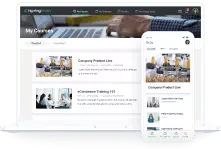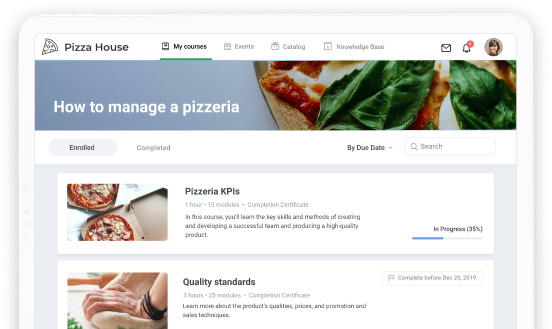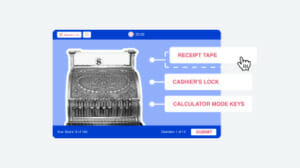The 10 Best Employee Training Management and Tracking Software in 2024

However, if training is being delivered but employees’ results aren’t getting monitored, only half the work is getting accomplished. This is why you need employee training management software.
By tracking employee training via employee training tracking software, you can ensure that the employees learn what they are supposed to, your training program is effective, and that this is a worthwhile investment for your company.
In this article, we’ll consider 10 great employee management and tracking software that will help you monitor your employees’ progress without the hassle of paper reports and daunting spreadsheets. But before we review these solutions, let’s see what’s special about these tools and how they can benefit businesses.
What is Training Management and Tracking Software?
Employee training management software is better known as a learning management system or LMS.
Employee training software allows you to create or at least upload eLearning training courses, assign training content to individuals or groups of employees, carry out certification, keep track of learners’ performance, and evaluate results. It’s like having your own online university in which the most tedious tasks, such as grading, processing statistics, and managing employee training records, are automated.
Benefits of Using Employee Training Management Software
A training management system or software solution is a winning strategy for organizations and businesses that want to optimize and improve the employee training process. Without proper tracking, you’ll simply be unaware of how effective your training protocols are and how they contribute to operational processes and business results.
Here’s what quality employee training management software can offer:
- Automated training delivery. You can upload training materials to an LMS, set up trainee groups, and the software will deliver the right online learning programs to the right employees automatically. The system also sends notifications and reminders to each user, helping them stay on track with courses and assignments that are in progress.
- Streamlined training management. With an LMS, you can manage training courses like a pro. Easily schedule and assign training, add new users, and monitor real-time engagement metrics—all from a centralized platform. This is a sure way to boost the administrative efficiency of all training initiatives in your organization.
- In-depth training progress analytics. Training management software also functions as an employee training tracker, providing actionable insights into individual and team achievements. Through such key features as user-friendly dashboards and detailed reports, managers can easily monitor completed modules, assess quiz and test scores, and identify areas for improvement. This way, you can identify trends, swiftly address skill gaps, and align your training to changing company needs.
- Enhanced compliance management. Employee training management software automates the tracking of compliance training. It sends timely reminders for renewal and generates compliance reports, which helps you reduce the risk of non-compliance and associated penalties.
So, if you need to upskill your staff and manage training compliance effectively, consider trying out some of the employee training software solutions covered below. It will lighten your workload, save you time, and allow your employees to perform better.
Best Training Management and Tracking Software in 2024
All ten LMSs presented in this review are cloud-based solutions. “Cloud-based” means that a system works on the Web and doesn’t require a setup procedure. Cloud solutions are usually preferred by those who want to begin working right away and avoid lengthy implementation.
Also, all the platforms are very intuitive, mobile-friendly, and support various types of content. In our review, we will focus on their standout features and define use cases for each platform.
1. iSpring Learn
Rating: 4.7/5 – 138 reviews (Capterra)
The vendor’s promise: “Fast LMS for your mission-critical project.”
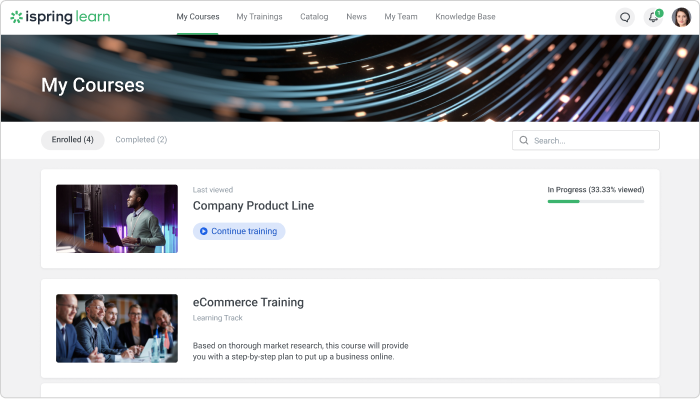
iSpring Learn is an easy-to-use cloud-based LMS for training and assessing employees online.
What differentiates iSpring Learn from its competitors is a powerful authoring toolkit integrated with the LMS. Unlike built-in course builders that some LMSs include, iSpring Suite allows capabilities beyond embedding a video from YouTube and creating simplistic text courses. With its help, a course developer or even a training manager with no ID experience can build high-end interactive eLearning with advanced assessments, video lectures, and communication simulations.
iSpring Learn offers excellent training tracking capabilities. Managers can see the training progress of a team or individual learners on an intuitive dashboard. It’s easy to analyze key training metrics, including ongoing progress, time spent on a course, assessment scores, quiz attempts, and more. You can also use it to conduct 360-degree employee performance appraisals to identify employees’ strengths and areas for improvement.

Another huge benefit of iSpring Learn is how well it incorporates gamification features into the training process. Trainees get badges and other awards for completing training modules successfully. They can also compete with each other and see the results on an interactive leaderboard. This makes it easier for HR managers and trainers to incentivize employees and spark learner engagement organically.
On top of that, iSpring Learn has an array of social learning features, such as comment sections for discussion and the option for private messaging if trainees want to interact with other participants directly. To bring employees even closer together, you can even set up customized birthday announcements to encourage employees to celebrate each other’s milestones and foster a sense of community.
Pricing
iSpring Learn comes in two subscription options – Start and Business. With the Start subscription, you get all the basic LMS functionally needed for effective employee training. The Business subscription provides all the features of the Start version plus a unique set of additional capabilities.
Both subscriptions use an active-user pricing model. This means that you can register any number of users, but a user is considered active only if they logged in at least once during a given month. iSpring Learn’s plans range from $2.99 per active user per month for 50 users to $2.55 per user per month for 1,000 users.
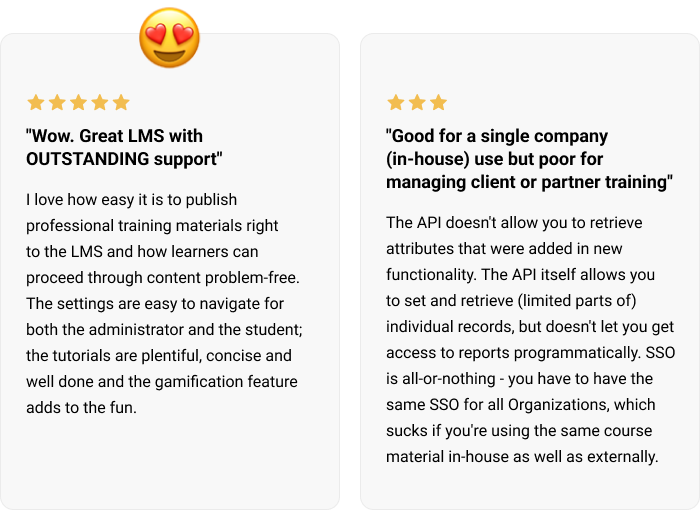
Actual reviews by iSpring Learn users. Source: Capterra
2. Docebo
Rating: 4.3/5 – 175 reviews (Capterra)
The vendor’s promise: “Align the training needs of your organization with those of your learners with an LMS that uses learning-specific artificial intelligence algorithms to produce deeper and more effective learning experiences.”
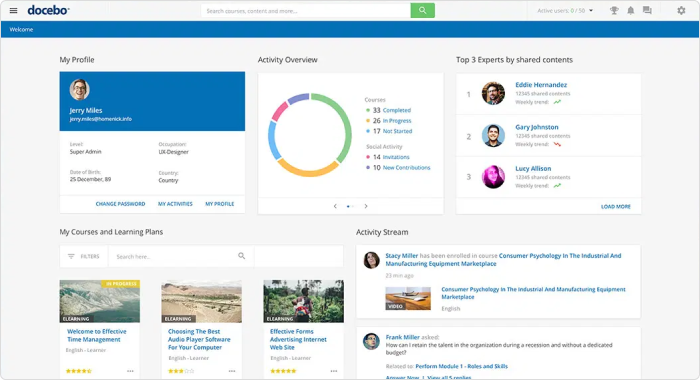
Docebo is a flexible and scalable platform that offers a comprehensive enterprise learning solution.
Two of Docebo’s features that strike the eye right after signing up are its white labeling and branding options. In most LMSs, extensive page customization is something of a privilege. In Docebo, you can customize literally everything: from a sign-in page background to the look of a course catalog; you can even set up your logo and colors for their mobile app.
In addition to visual customization, the platform provides extensive localization. Available in 40 languages, it benefits extended international enterprises and industries that need to train employees all around the world. One might notice that some of the localizations seem like they’ve been translated by a machine. However, once you have this basic translation, you can download your own language template and improve it.
Another great thing about Docebo is Coach and Share, a solution for informal social learning that encourages creating user-generated content. Employees can share their insights and best-practices by contributing presentations, guides, or video instructions to channels. Learners can also ask for feedback or help with the materials. They can get answers from other users or internal subject-matter experts in a way that’s similar to a helpdesk: the experts can see a list of pending questions and respond to them.
Pricing
Docebo’s pricing plans vary depending on your number of learners, features needed, and services provided. According to FindAnLMS, the annual pricing starts at $2,000 and can reach $500,000. You can only get exact values by sending a price request to the provider.
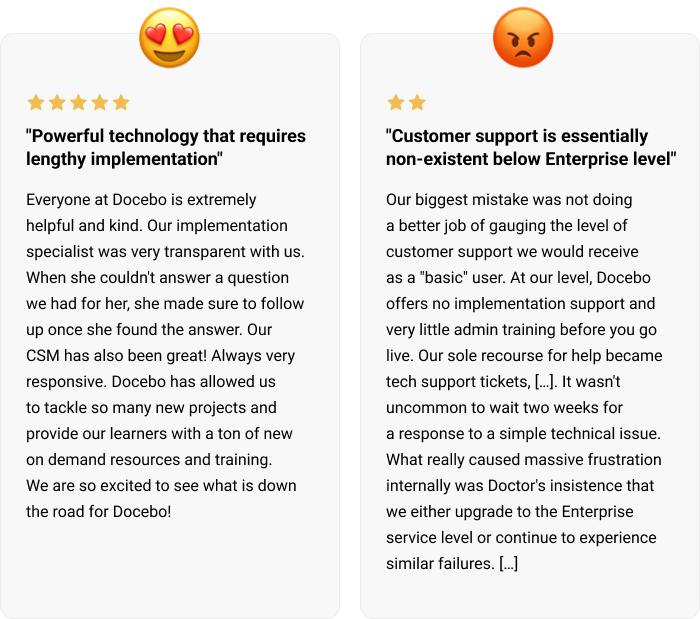
Actual reviews by Docebo users. Source: Capterra
3. LearnUpon
Rating: 4.9/5 – 90 reviews (Capterra)
The vendor’s promise: “Learning as it should be. Train your employees, partners, and customers with LearnUpon’s LMS. Manage, track, and achieve your learning goals — all through a single, powerful solution.”
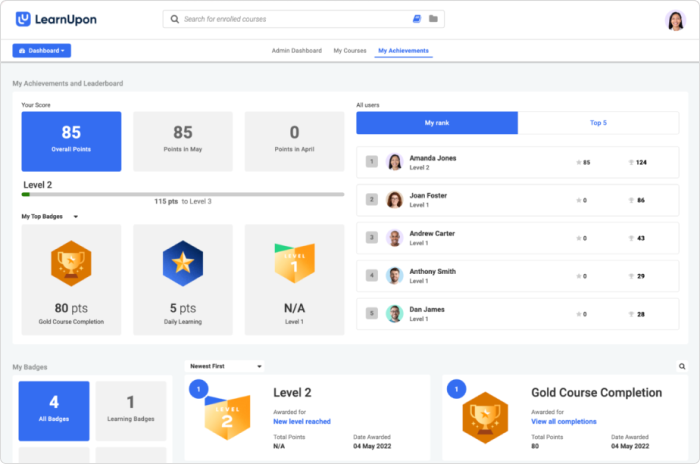
LearnUpon is a versatile platform that can be used for both internal employee training and external partner training.
The LearnUpon designers did a great job, as the platform interface seems to be neat and user friendly, so you’ll likely figure out most of the platform’s capabilities without any training. At the same time, each customer has a personal relationship manager who attends to any possible issues.
While the company provides its customers with top-notch support at every level, the functionality of this training management software correlates with the pricing plan. So, if you start with the Basic plan — it costs as much as €599 (~$663) per month — you won’t have features such as gamification, assignments, and facilities for blended learning, which are available with the upper plans.
Another feature that is smoothly implemented in LearnUpon (but depends on the plan you choose) is easy switching between learning portals. This allows you to create and customize individual learning environments for different types of learners — employees or partners — or organizations.
Pricing
A LearnUpon Basic plan will set you back €599 (~$663) monthly for up to 50 active users. Upgrading the plan increases the number of users and available features. So, at €999 (~$1,106) per month, you can create two learning portals, incorporate blended learning, use gamification, assignments, and e-commerce features, and have up to 250 users. For €1,699 (~$1,873), you can also rely on some additional integrations, SSO, and a larger number of users.
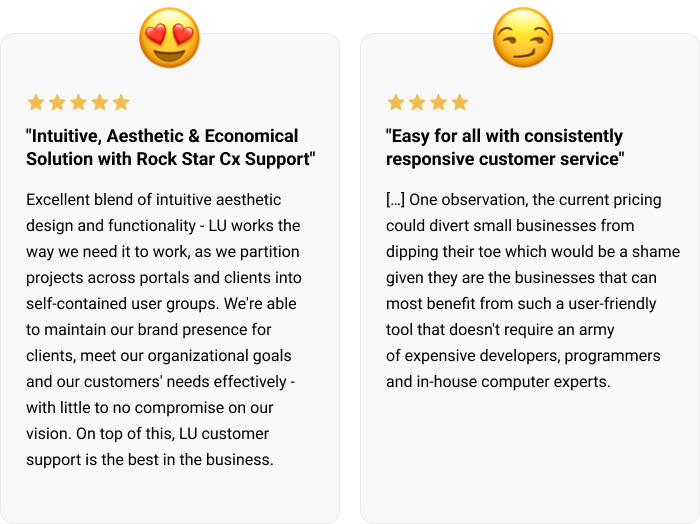
Actual reviews by LearnUpon users. Source: Capterra
4. Litmos
Rating: 4.2/5 – 277 reviews (Capterra)
Vendor’s promise: “Training in the NOW. #1 Training Platform for Customer-Oriented Enterprises.”
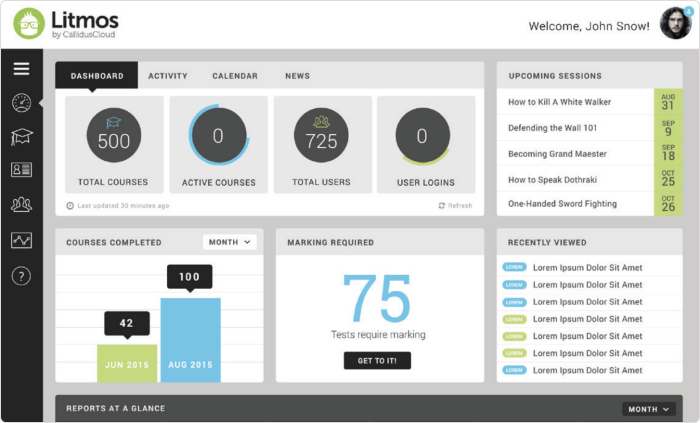
SAP Litmos is a cloud-based LMS designed to launch, deliver, and track on-demand employee training for thousands of learners quickly. It’s also a user-friendly system for both the admin and the learner, as its design looks nice, and the interface is self-explanatory.
SAP Litmos created Litmos Heroes, a huge marketplace where you can access over 15,000 off-the-shelf learning resources for any industry. The courses are made in a bite-sized video format (5 to 20 minutes long), which is good for learner engagement.
Together with a built-in editor that allows you to create simple eLearning content, it makes a good choice for the companies that don’t currently have an instructional designer or would like to save both time and money on producing their own employee training content.
Pricing
SAP Litmos offers two pricing plans. One is the actual LMS billed per user per month, and another includes access to the Litmos Heroes course collection.
For those only seeking an LMS, it’ll be $6 or $4 per user if the company falls into the 150-500 or 500-1,000 user tier, respectively. If you have fewer than 150 users per month, you can only choose the plan with their course library ($15 per user). And, of course, there are custom plans for those who have over 1,000 learners per month.
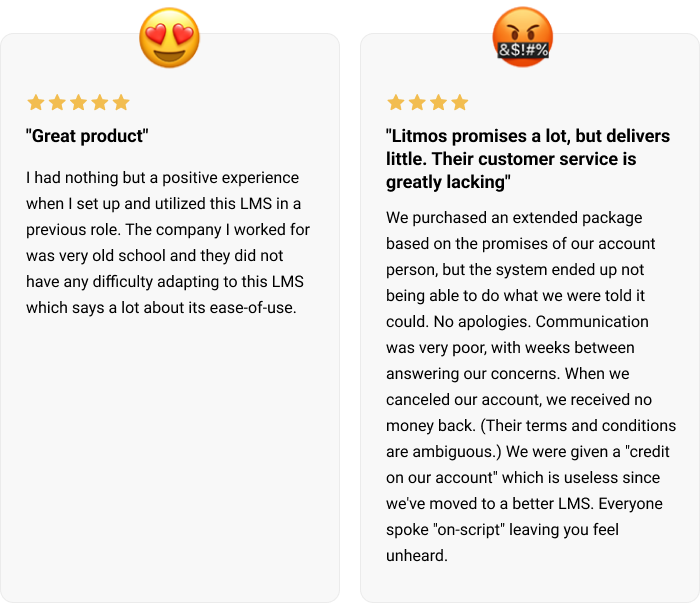
Actual reviews by SAP Litmos users. Source: Capterra
5. TalentLMS
Rating: 4.7/5 – 531 reviews (Capterra)
The vendor’s promise: “The fastest path to better training. A super-easy, cloud LMS software to train your employees, partners, and customers.”
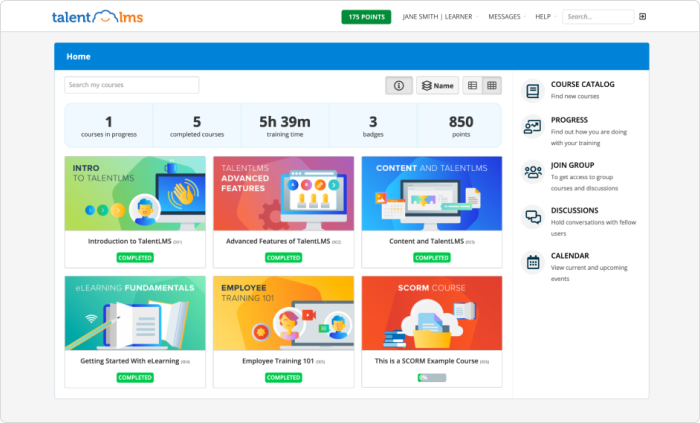
Although all the learning management systems in this list are quite user friendly (except Docebo, perhaps), TalentLMS seems to take it to the next level. After you sign up for a trial, you’re met by a well thought out product tour that walks you through the first steps and makes you feel at home with the main features the platform offers.
The LMS is also distinguished by flexible gamification settings. TalentLMS’s gamification engine allows you to add gaming and competition elements in the proper places, and configure it to meet particular use cases. For example, you can create some hidden bonus content that is only available to learners who have reached a certain level.
The TalentLMS developers have also worked on integrations with many useful tools. There are over 200 integrations with third-party services, including Zapier, Shopify, Salesforce, WordPress, Slack, Zendesk, GoToMeeting, Trello, PayPal, and Stripe. It’s pretty cool for those who have a rich environment of different services, as you won’t have to pay extra to link everything together.
Pricing
To start with, TalentLMS allows you to choose whether you’d like to be charged for the total number of registered users or for active users per month. Then you can also choose to be billed monthly or yearly (yearly is cheaper).
The plans range from $69/month for 40 registered learners to $459/month for 1,000. For the sake of comparison, 40 active users will be charged $149 a month, while for 500, there’s almost no difference — it’s $519/month.
Also, if you want to start really small, you can give their free plan a try. This allows you to have only 5 registered users and 10 courses on the learning portal, which is very little even for the smallest businesses, but it’s enough to get your feet wet.
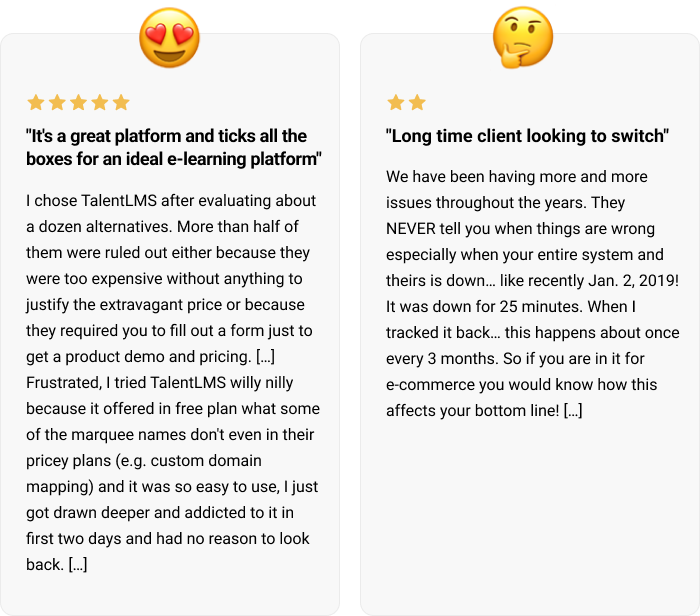
Actual reviews by TalentLMS users. Source: Capterra
6. 360Learning
Rating: 4.7/5 – 362 reviews (Capterra)
The vendor’s promise: “Upskill from within. Discover the learning platform powered by collaborative learning.”
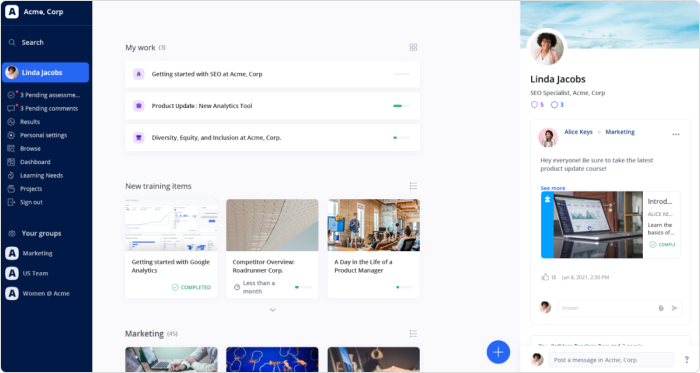
360Learning is a robust employee training management and tracking software with a strong focus on collaborative learning experiences. This makes it more of a learning experience platform (LXP) that empowers employees to greatly impact the training process by maintaining discussions, upvoting comments, and sharing reactions.
360Learning is also great from the perspective of content authoring and curation. You can curate the training content in a way that best suits certain career tracks. Or you can leverage the power of AI to recommend a course to employees based on their skills and aspirations toward internal mobility.
Another thing that makes the platform stand out is a wealth of skills mapping functionalities like tags and skill insight dashboards. They allow for targeted training and effective workforce planning within an organization.
Also read: A Supervisor Dashboard: Track Learner Progress with iSpring Learn
Also, 360Learning is replete with a number of helpful third-party integrations. They can help you keep training seamlessly embedded in the workflow and manage blended learning programs with ease.
Pricing
360Learning features the Team and Business pricing models. Team is a more straightforward solution for companies that have up to 100 registered users monthly. The price is $8 per user/ month. The price for a Business subscription is available upon request.
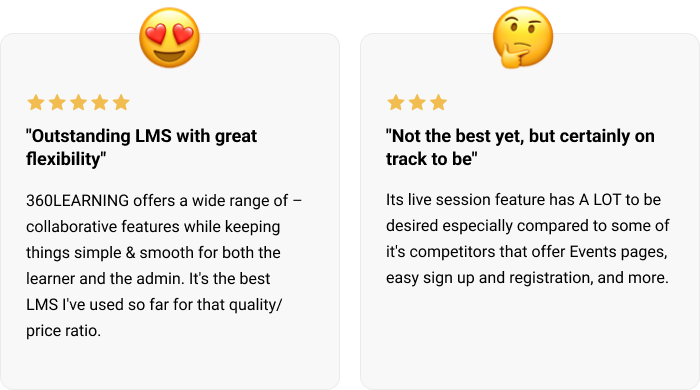
Actual reviews by 360LEARNING users. Source: Capterra
7. Canvas
Rating: 4.6 /5 – 3,912 reviews (Capterra)
The vendor’s promise: “Engaging, effective employee training software.”
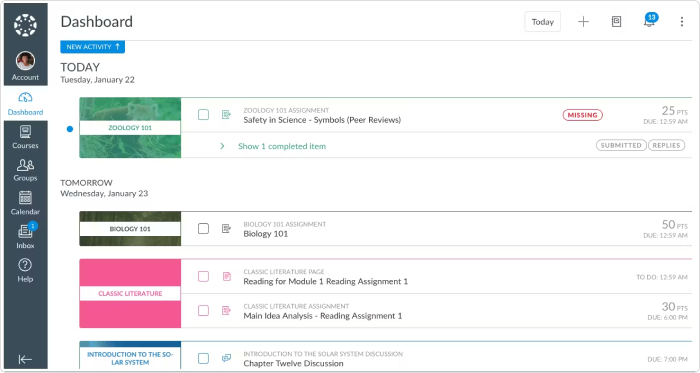
Canvas is a prominent player in the LMS market for the K-12 and higher education sectors, but it is also renowned in the corporate education arena. It comes bundled with a few helpful extensions including course catalog, digital credentials, video studio, and collaborative Canvas LMS. Altogether, they can assist with employee training management and reinforce training greatly.
For instance, Canvas Catalog enables training specialists to create customized collections and sub-catalog listings, bundle them together, and enjoy easy progress tracking.
In turn, Canvas Credentials can be used to allot digital badges and issue certificates for completing microcredentials. This can be particularly useful for organizations that need to bridge particular skill gaps and verify an employee’s competence in a specific area.
Finally, Canvas works well for scheduling both online and offline activities, and can be an option for those companies that conduct virtual instructor-led training programs.
Pricing
Canvas comes in a free-for-teacher and a paid edition (available upon request).
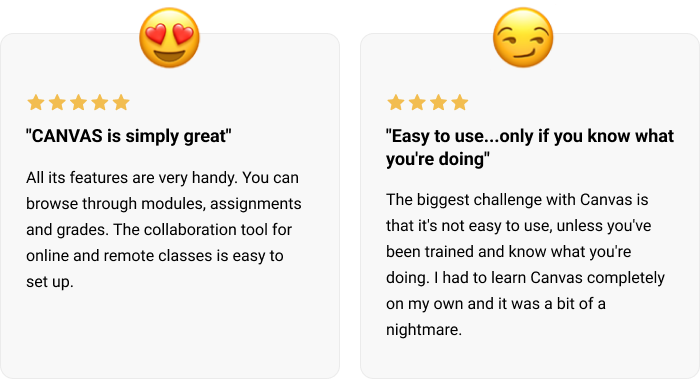
Actual reviews by Canvas users. Source: Capterra
8. Absorb
Rating: 4.5/5 – 237 reviews (Capterra)
The vendor’s promise: “Enable learning everywhere through an easy-to-use and personalized enterprise LMS that seamlessly blends an engaging learner and effective admin experience.”
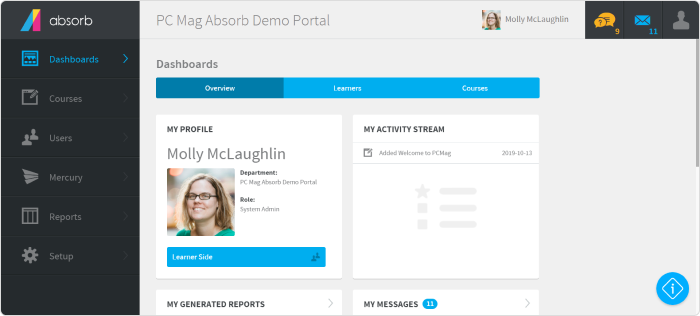
Absorb is another AI-powered LMS that can connect your employees with the training content that’s most relevant for them. The same AI engine removes the headache of managing day-to-day training tasks for L&D pros. You can get needed statistics and track employee training much faster by formulating requests in natural language.
In Absorb, it is possible to navigate through reports conveniently, customize them as desired, and save reports as presets. You also take the necessary action right from the reports tab — reassign a course to a specific group of employees, for example.
What is more, Absorb fosters a targeted approach to tracking training and fuses it into daily workflows seamlessly. For example, you can conduct scalable on-the-job performance reviews with its observation checklists. They are available in the mobile app as well and are suitable for inexperienced users.
Pricing
Absorb claims that they have tailored pricing and base it on the needs of a given company.
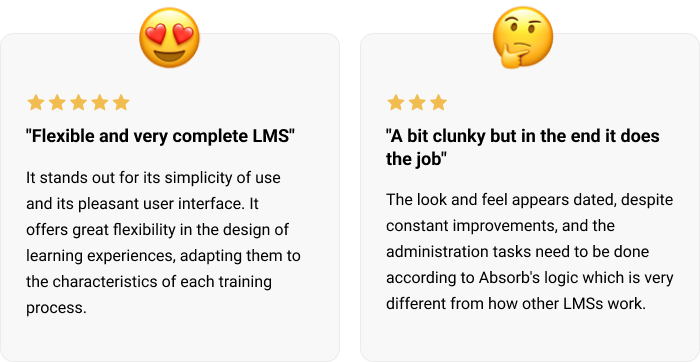
Actual reviews by Absorb users. Source: Capterra
9. LearnDash
Rating: 4.6/5 – 262 reviews – (Capterra)
The vendor’s promise: “The most powerful learning management system for WordPress.”
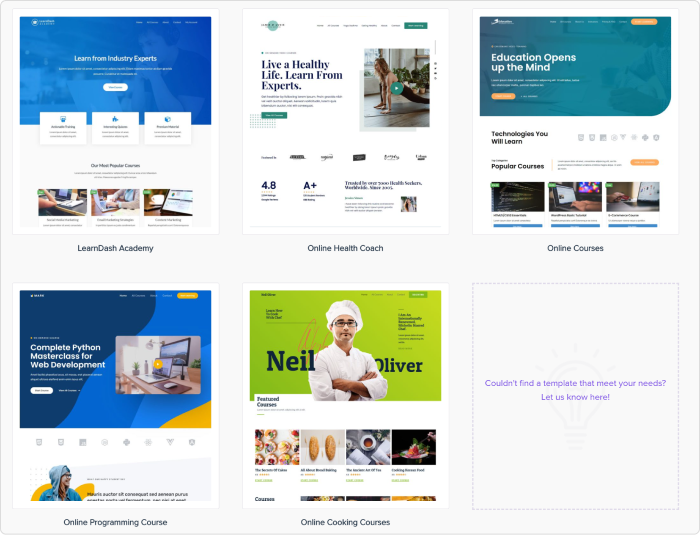
LearnDash is unique in that it allows you to merge the tasks of employee training management with your corporate website. It works like a plug-in and ensures simplicity of use both for learners and training specialists.
LearnDash enables you to organize content in learning paths, configure levels of access, and adjust the pace of content delivery. It should be noted that LearnDash has a drag-and-drop course builder that you can use to create multimedia online courses right on the website.
However, the LMS has limited compatibility with the most popular eLearning formats, SCORM and xAPI. This means that the process of content migration may be troublesome and require purchasing third-party add-ons. The same goes for reporting features, which can be added only with other LearnDash plug-ins.
Pricing
The LearnDash plug-in is available for $199/year for one site and $399/year for up to 10 sites. Businesses can purchase extra cloud space with hosting included. The price for the cloud space ranges from $25 to $83 per month, depending on the plan.
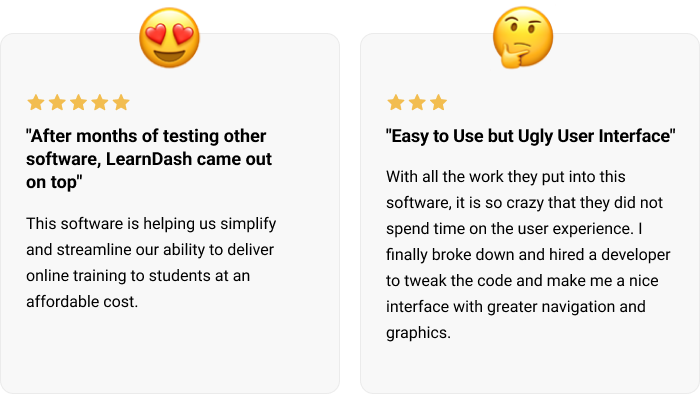
Actual reviews by LearnDash users. Source: Capterra
10. Adobe Learning Manager
Rating: 4.3/5 – 670 reviews – (Capterra)
The vendor’s promise: “The award-winning learning platform that integrates learning experiences into your brand’s website and apps.”
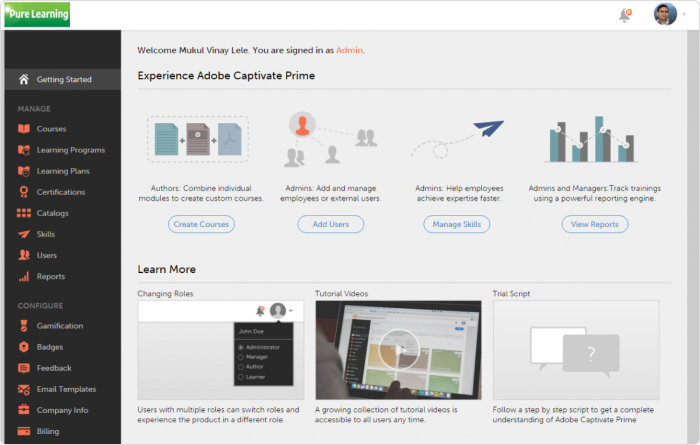
Adobe Learning Manager, formerly Adobe Captivate Prime, is one of the most trusted LMS solutions on the market that suits a wide range of training scenarios, from customer and partner training to full-scale employee development.
This LMS has been enhanced with AI content curation tools and extended learning personalization options. The platform also features multi-tenancy, which helps to separate different learning audiences and is particularly important for enterprises.
If there is a need for outsourced training content, companies can enjoy off-the-shelf courses from the content marketplace and the integration with LinkedIn Learning. The LMS doesn’t provide any built-in course creation tools that can be used by admins. However, learners can create audios, videos, and screen captures right on the platform and share them with peers.
Adobe Learning Manager is moving toward a ‘headless LMS’ that is somehow related to what LearnDash does. Thanks to a suite of APIs, learning content can be available directly on your website, and the system integrates with its front end seamlessly.
Pricing
Adobe Learning Manager is available in two pricing models: per registered or per active user. The price for each one is available upon request. The ‘headless LMS’ feature can be purchased separately.
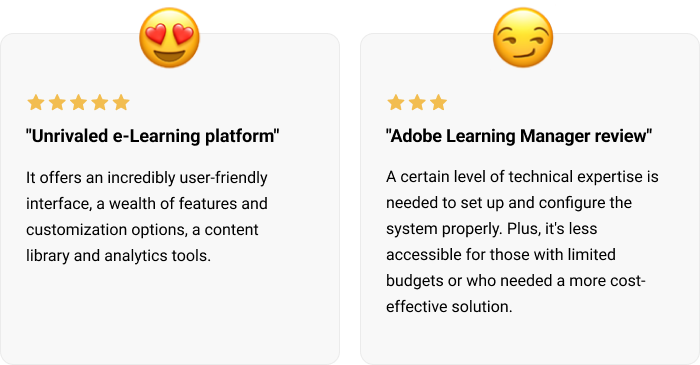
Actual reviews by Adobe users. Source: Capterra
4 Tips for Selecting the Right Training Management and Tracking Software
With such an abundance of employee training management software solutions, how do you choose the best tool to track employee training in your organization? To help you make the right decision, we’ve put together a list of useful tips.
Tip 1. Assess your training goals
Begin by clearly defining your organization’s training goals. What skills and knowledge do you want employees to acquire? What are the desired outcomes? Consider factors such as compliance requirements, skill gaps, and performance improvement goals.
This assessment will guide you in picking training management software that aligns with your specific needs.
Example: If one of your major training objectives is to boost employee engagement and proactivity, you might want to choose training management software that offers interactive and gamified learning modules, real-time employee training progress tracking, and collaboration features like discussion forums.
Tip 2. Evaluate the scalability of the training tracking software
As your organization grows and scales, so will your training needs. Look for a training management system that’s scalable and flexible enough to accommodate possible changes in training requirements.
Example: If you’ve just launched a new department and hired a number of new employees, you need to add multiple new users and relevant training materials to your LMS quickly, with no system disruptions. That’s why it’s important to choose software that has flexible seat and storage plans and can accommodate the increased demand seamlessly.
Tip 3. Look for mobile training functionality
Mobile training is a great functionality that allows your employees to learn at a comfortable pace from any location or device. If that’s something you prioritize, opt for an LMS that has apps for mLearning. Trainees can use such apps to access training materials both online and offline, and you’ll still be able to track progress and assess the results of their training accurately.
Example: If you have sales reps who often travel to meet prospective clients, they can check sales strategies, product updates, and client engagement techniques while on the go via an LMS app. This will help them to be prepared and confident at all times.
Tip 4. Check available integrations
Many modern employee training management systems regularly add integrations with third-party tools to enhance the user experience. You can find integrations with CRMs, HRIS, eCommerce platforms, calendars, productivity booster software, online meeting platforms, and more. Go for an LMS that integrates with tools that are most relevant to your training and business goals.
Example: If you want to help HR managers streamline their processes, look for an LMS that integrates seamlessly with HRIS (Human Resource Information System) software. This integration ensures that employee training data syncs with HR records automatically, which simplifies the tracking of individual progress and skill development.
Also read:
The 11 Best HR Tools for Streamlining Your Workflow in 2023
12 LMS Benefits for Recruiters, HR, Sales, and Commercial Directors—Expert Opinion
FAQ on Employee Training Tracking Software
Let’s look at a few more questions you might have about training employees effectively with training management software.
Who needs a learning management system?
As its name implies, a learning management system can benefit everyone who deals with educating people. More specifically, it can help:
- Learning and development departments. Many companies around the world have L&D departments and training managers who use LMSs to schedule training sessions, deliver training programs to employees, and assess the staff’s knowledge and skills.
- Human resources departments. Some businesses don’t have dedicated L&D departments, but have HR professionals who curate training content.
- Training businesses. Such companies leverage LMSs to manage learning courses that can be sold as a service to corporations that don’t use training management systems on their own.
How can I measure employee training effectiveness?
First, you need to equip yourself with one of the approaches to training evaluation (e.g., the Kirkpatrick Model or the Learning-Transfer Evaluation Model). Then, identify a particular set of required metrics that your training tracking software provides and monitor them regularly. Learn more about employee training metrics here.
What is the best way to track training?
You can track training conveniently via an LMS. A good learning management system features powerful reporting and works as a training tracker. It gathers employee training records and presents them as a variety of reports. This allows you to track employee progress in training and learn how your entire team or individual team members are performing at any time without having to ask them.
When using such employee training software, you can track compliance training using a variety of metrics. For example, you can see how:
- Learners proceed through a training program, read through materials, and interact with the content
- A specific employee takes courses and quizzes, their statuses, scores, number of attempts, time spent, and more
- Your team members attend offline employee training events and virtual training sessions
For users’ convenience, modern training tracking software solutions typically have a visual board that enables them to get a picture of what’s going on at a glance.
Many employee training tracking software also have filters that let users navigate the training data more easily and get required reports quickly. For example, training managers can easily check out the statuses of courses assigned to a certain learner or find out how a specific department is progressing.
Conclusion
Here’s the bottom line for choosing employee training and tracking software effectively: As you’ve probably noticed, despite the many things they may have in common, like being easy-to-use cloud services, each of them has a unique set of features, services, and pricing plans.
We recommend that you give these training management software a try with a free trial version or a demo request to see how each LMS tackles your specific needs and find the solution that meets them best.
Looking for employee training tracking software that’s easy to use but has powerful LMS functionality and great content authoring capabilities? Book a free demo of the iSpring Learn LMS and learn how it will help address your training needs.
